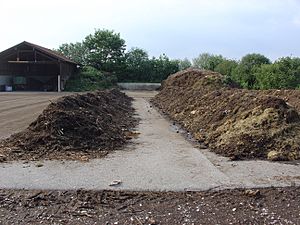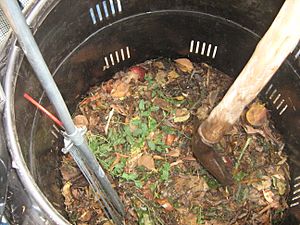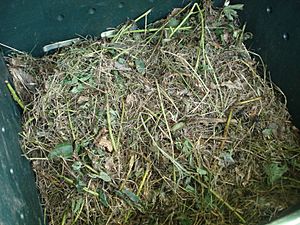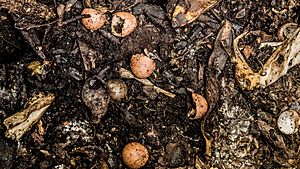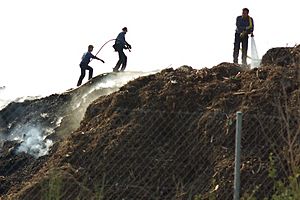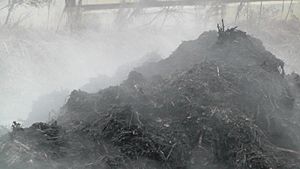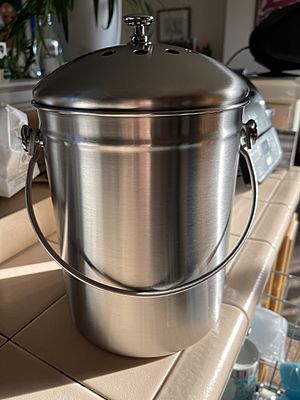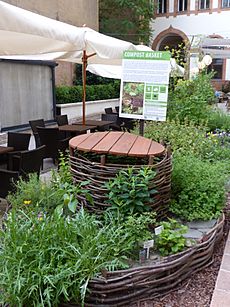Compost facts for kids
Compost is a special mix of ingredients that helps plants grow strong and healthy. It's also great for making soil better. People usually make compost by letting plant scraps, food waste, and animal manure break down naturally.
This amazing mixture is full of good stuff for plants, like important nutrients and helpful tiny living things such as bacteria and fungi. Using compost in gardens, farms, and parks can make the soil more fertile. It can also mean we don't need to use as many chemical fertilizers.
To make compost, you need a mix of 'greens' and 'browns'. 'Greens' are things rich in nitrogen, like fresh leaves, grass clippings, and food scraps. 'Browns' are woody materials rich in carbon, such as dry stalks, paper, and wood chips. It takes a few months for these materials to break down into a rich, dark material called humus. Composting can be a simple process or a more controlled one, where you carefully add water, air, and the right mix of greens and browns.
The process of breaking down happens faster if you shred the plant material into smaller pieces. Adding water and regularly turning the compost pile with a pitchfork also helps speed things up. Tiny fungi, earthworms, and other small creatures help break down the organic material even more.
Composting is super important for managing our waste. About 20% of the trash in landfills is food and other compostable materials. These things take a long time to break down in a landfill. Composting helps the environment and can even save money. For example, compost can be used to fix damaged land, build wetlands, and cover landfills.
How Compost Works
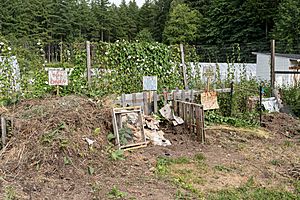
Composting is a way of breaking down organic waste using air. It's like recycling natural materials. This process turns organic stuff into a dark, rich material called compost, which is a fantastic fertilizer for plants.
For composting to work well, tiny living things (microbes) need four main things:
- Carbon gives them energy. Materials high in carbon are usually brown and dry.
- Nitrogen helps them grow and make more microbes. Materials high in nitrogen are often green and wet, like fruit and vegetable scraps.
- Oxygen is needed for the microbes to break down the carbon. They need enough air to do their job.
- Water is important to keep the microbes active, but not too much, or the pile can get soggy.
Having the right amounts of these ingredients helps the microbes work fast and make the compost pile warm. Turning the compost pile regularly helps keep the right amount of oxygen and moisture. This balance is key to keeping the pile warm (around 54–71°C or 130–160°F) until everything breaks down.
Most dead plants and animal materials have both carbon and nitrogen. For example, fresh grass clippings have more nitrogen, while dry autumn leaves have more carbon. Composting is an ongoing process, so it's good to keep adding new materials and managing the pile.
Tiny Helpers in Compost
Many different tiny living things help break down organic matter in compost. They need the right mix of water, oxygen, carbon, and nitrogen to do their job. These helpers can be divided into two groups: chemical decomposers and physical decomposers.
Chemical Decomposers
These tiny helpers do chemical work to break down waste.
- Bacteria are the most important and common helpers in compost. They process carbon and nitrogen, releasing nutrients that plants can use. Some bacteria like cooler temperatures (mesophilic), while others like hotter temperatures (thermophilic). Hot-loving bacteria become active when the pile heats up, reaching 40–60°C (104–140°F).
- Actinomycetota are special bacteria that help break down tough materials like paper, bark, and wood. They give compost its pleasant earthy smell.
- Fungi like molds and yeast help break down materials that bacteria can't, especially the tough parts of woody materials.
- Protozoa are tiny single-celled creatures that also help break down organic matter and eat other tiny microbes.
Physical Decomposers
These helpers break down waste into smaller pieces by chewing, tearing, or digesting it.
- Ants create tunnels, making the compost more airy and moving nutrients around.
- Beetles have grubs that eat decaying vegetables.
- Earthworm]]s eat partly composted material and leave behind nutrient-rich "worm castings." Their tunnels also help air and water move through the compost.
- Flies eat organic material and add bacteria to the compost.
- Millipedes break down plant material.
- Snails and slugs eat fresh plant material. It's best to remove them before using the compost, as they can harm plants.
- Sow bugs eat rotting wood and decaying plants.
- Springtails eat fungi, mold, and decaying plants.
Hot vs. Cold Composting
The time it takes to make compost depends on how much material you have, how small the pieces are, and how often you mix it.
Hot composting uses larger piles that get very warm and stay hot for days or weeks. This is common for big composting places. The 'Berkeley method' can make compost in just 18 days! It needs a large pile (at least 1 cubic meter) and turning every two days after the first four days. This method uses smaller, more uniform pieces and careful control of carbon-to-nitrogen ratio and moisture.
Cold composting is a slower process, sometimes taking up to a year. This happens with smaller piles, like many home compost bins, where small amounts of kitchen and garden waste are added over time. Smaller piles usually don't get very hot. You don't need to turn cold compost as often, but parts of the pile might get too wet or packed down, leading to bad smells.
Keeping Compost Safe
Composting can destroy some unwanted germs and seeds, especially when it gets hot (above 50°C or 122°F). When compost reaches 50–70°C (122–158°F), it kills most harmful germs. The temperature needed to kill a germ depends on the germ itself, how long the heat lasts, and the pH level.
Compost products, like compost tea, can also help plants fight off diseases. They contain helpful microbes and enzymes that stop plant pathogens.
When handling compost that hasn't reached high temperatures, it's a good idea to wear a mouth mask and gloves. This helps protect you from any unwanted tiny living things that might be present.
Composting at home also helps the environment by reducing the amount of green waste that goes to landfills. This means fewer trucks are needed to pick up trash, which lowers pollution.
What Can Be Composted?
You can compost many different things from homes, farms, and businesses. You can compost food or yard waste at home, or it might be collected for a large composting facility.
Organic Solid Waste
There are two main types of organic waste for composting:
- Green waste is usually a source of nitrogen. This includes food scraps (before and after eating), grass clippings, garden trimmings, and fresh leaves.
- Brown waste is a source of carbon. Examples are dried plants, woody materials like fallen leaves, straw, woodchips, and sawdust. Paper and plain cardboard also count as brown waste.
Animal Manure and Bedding
On farms, animal manure (poop) is a great source of nitrogen for compost. Bedding materials like straw and sawdust are used as the carbon source. Different types of manure need different mixes. For example, wet pig manure needs to be mixed with straw.
Human Waste
Human excreta (poop and pee) can also be composted because it's rich in nutrients. Poop has nitrogen, which plants need for growth. Pee has phosphorus, which helps plants use sunlight.
Special composting toilets collect solid human waste. Or, after treatment at a sewage treatment plant, it can become biosolids that can be composted. It's very important that these processes are designed and managed carefully because human waste can contain many types of germs. Improper handling can be risky.
Pee can be added to compost piles or used directly as fertilizer. Adding pee can make compost piles hotter, which helps kill germs and unwanted seeds. Unlike poop, pee doesn't attract flies and doesn't contain the toughest germs.
Animal Remains
Animal carcasses can also be composted as a way to dispose of them. This material is very rich in nitrogen.
How We Use Compost
For Growing Plants
In big fields for crops like wheat or corn, compost can be spread thinly over the soil before planting. For very poor soil, a thicker layer might be used to help it recover.
For plants grown under plastic covers (like strawberries or tomatoes), compost can be mixed into the soil in strips or used as a top layer.
Many plants are started as tiny seedlings in greenhouses before being moved to the field. Compost can be part of the soil mix used to grow these seedlings. It's usually mixed with other materials like soil, sand, or peat. Compost makes the soil richer and helps it hold moisture and nutrients.
Compost is dark brown or black and smells earthy when it's ready to use. It's usually not recommended to plant seeds directly into pure compost because it can dry out quickly or contain things that stop seeds from sprouting. However, mixing 20–30% compost into soil is great for transplanting young plants.
Compost can also help plants become stronger and more resistant to diseases and pests.
Compost Tea
Compost tea is made by soaking compost in water. You can stir it occasionally to release the tiny microbes. Some people aerate (add air to) the tea, while others don't.
Studies show that adding compost teas to crops can help them grow better, provide more nutrients, and increase helpful microbial activity. They can also help fight plant diseases.
Compost Extract
Compost extracts are similar to compost tea but are not fermented or brewed. They are simply the liquid from compost dissolved in a solvent.
Selling Compost
Compost is sold in bags at garden stores. These mixes might include composted manure, peat, soil, and other things. There are different types for different plants, like general-purpose compost or special mixes for vegetables or flowers.
Other Uses
Compost can also be used to fix damaged land, build wetlands, and cover landfills. The heat from compost can even be used to warm up greenhouses if placed around their edges.
Rules for Compost
Many countries have rules about how compost should be made and what quality it needs to be. These rules help make sure compost is safe and good for use. For example, in the United States, some rules for large-scale composting were first made for treated sewage sludge (biosolids).
Some cities, like Seattle and San Francisco, require people to sort their food and yard waste for composting. This helps reduce waste going to landfills.
There are also concerns about certain chemicals, like "forever chemicals" (PFASs), in compost made from sewage sludge. Experts recommend that home gardeners avoid using compost made from sewage sludge to be safe.
Compost Through History
People have been composting for a very long time, at least since the early Roman Empire. It was mentioned around 160 BCE by Cato the Elder. Back then, people would just pile up organic materials and let them break down until the next planting season. This was simple and fit well with farming. However, it took up space for a whole year, and some nutrients might have washed away. Also, unwanted germs or insects might not have been controlled.
Composting started to become more modern in the 1920s in Europe, especially for organic farming. The first big facility to turn city organic waste into compost was set up in Wels, Austria, in 1921. Important people who supported composting in farming include Rudolf Steiner and Sir Albert Howard. Composting ideas also came to America through people like J. I. Rodale and Scott Nearing.
See also
 In Spanish: Compost para niños
In Spanish: Compost para niños


